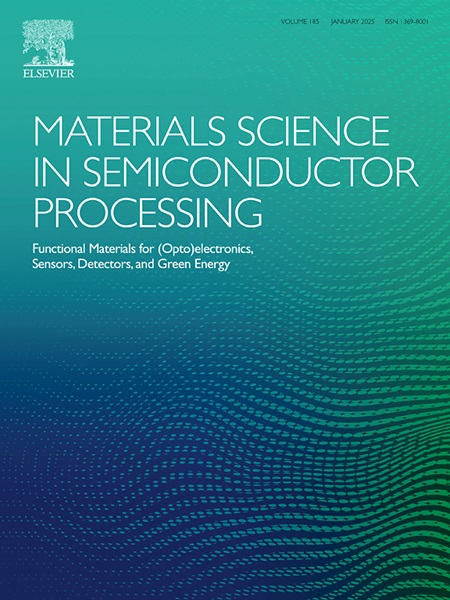金属辅助化学蚀刻纳米工程硅材料的热能收集
IF 4.2
3区 工程技术
Q2 ENGINEERING, ELECTRICAL & ELECTRONIC
引用次数: 0
摘要
低热废热能量收集代表了一种革命性的技术,为无线传感网络和电子设备供电,特别是在偏远和具有挑战性的环境中。本文综述了纳米多孔硅材料在热能收集中的应用,重点介绍了纳米多孔硅材料通过金属辅助化学蚀刻(MACE)的制备及其提高能量转换效率的独特性能。纳米多孔硅的高表面积体积比显著改善了热相互作用和热-电能量转换。我们分析了纳米多孔硅的材料特性和制备方法,并对其在热能收集应用中的性能进行了详细的评价。实验数据表明,纳米多孔硅在具有环境和经济优势的同时,实现了与传统材料相当的热电性能(ZT)。本文介绍了热电发电机的两种创新方法:固态配置和离子液体实现。通过系统的材料评估和应用演示,我们确定纳米多孔硅是一种高效环保的热能收集解决方案。我们的研究结果表明,纳米多孔硅不仅解决了传统热电材料的局限性,而且为提高能量收集系统的性能提供了一种可扩展和可持续的方法。这项研究有助于推进可持续能源技术和提高无线传感网络在各种环境条件下的可行性。本文章由计算机程序翻译,如有差异,请以英文原文为准。
Nanoengineering silicon materials by metal-assisted chemical etching for thermal energy harvesting
Low-thermal heat waste energy harvesting represents a transformative technology for powering wireless sensing networks and electronic devices, particularly in remote and challenging environments. This review comprehensively examines the utilization of nanoporous silicon materials for thermal energy harvesting applications, focusing on their fabrication through metal-assisted chemical etching (MACE) and their unique properties that enhance energy conversion efficiency. The high surface area-to-volume ratio of nanoporous silicon significantly improves heat interaction and thermal-to-electrical energy conversion. We analyze the material properties and fabrication methods of nanoporous silicon, providing detailed evaluation of its performance in thermal energy harvesting applications. Experimental data demonstrates that nanoporous silicon achieves thermoelectric figures of merit (ZT) comparable to traditional materials while offering environmental and economic advantages. The review presents two innovative approaches for thermoelectric generators: solid-state configurations and ionic liquid implementations. Through systematic material evaluation and application demonstrations, we establish nanoporous silicon as an efficient and environmentally friendly solution for thermal energy harvesting. Our findings indicate that nanoporous silicon not only addresses the limitations of conventional thermoelectric materials but also provides a scalable and sustainable approach for enhancing energy harvesting system performance. This research contributes to advancing sustainable energy technologies and improving the viability of wireless sensing networks across various environmental conditions.
求助全文
通过发布文献求助,成功后即可免费获取论文全文。
去求助
来源期刊

Materials Science in Semiconductor Processing
工程技术-材料科学:综合
CiteScore
8.00
自引率
4.90%
发文量
780
审稿时长
42 days
期刊介绍:
Materials Science in Semiconductor Processing provides a unique forum for the discussion of novel processing, applications and theoretical studies of functional materials and devices for (opto)electronics, sensors, detectors, biotechnology and green energy.
Each issue will aim to provide a snapshot of current insights, new achievements, breakthroughs and future trends in such diverse fields as microelectronics, energy conversion and storage, communications, biotechnology, (photo)catalysis, nano- and thin-film technology, hybrid and composite materials, chemical processing, vapor-phase deposition, device fabrication, and modelling, which are the backbone of advanced semiconductor processing and applications.
Coverage will include: advanced lithography for submicron devices; etching and related topics; ion implantation; damage evolution and related issues; plasma and thermal CVD; rapid thermal processing; advanced metallization and interconnect schemes; thin dielectric layers, oxidation; sol-gel processing; chemical bath and (electro)chemical deposition; compound semiconductor processing; new non-oxide materials and their applications; (macro)molecular and hybrid materials; molecular dynamics, ab-initio methods, Monte Carlo, etc.; new materials and processes for discrete and integrated circuits; magnetic materials and spintronics; heterostructures and quantum devices; engineering of the electrical and optical properties of semiconductors; crystal growth mechanisms; reliability, defect density, intrinsic impurities and defects.
 求助内容:
求助内容: 应助结果提醒方式:
应助结果提醒方式:


